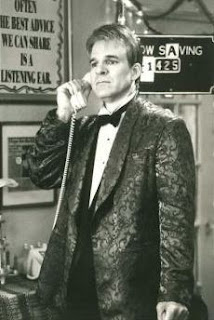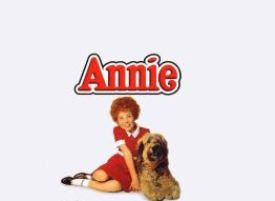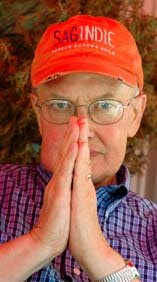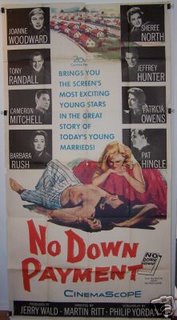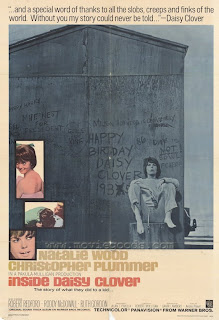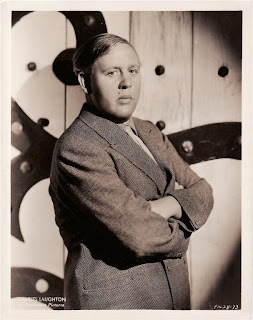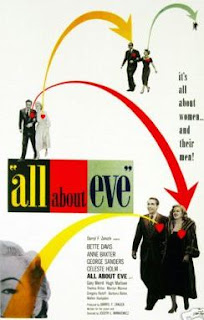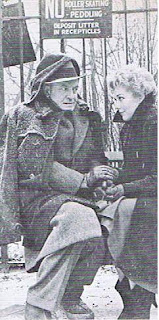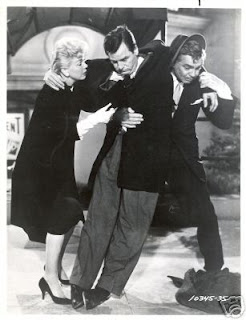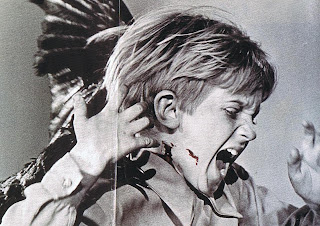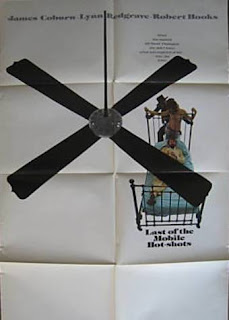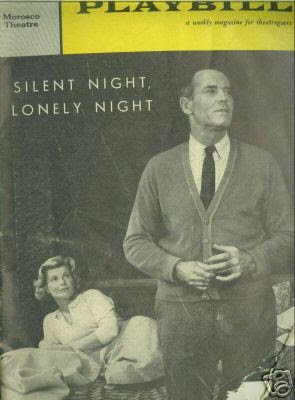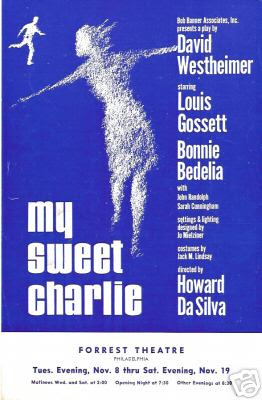 ........The missing production number from Hawks' "Blondes"........Note: This is a regular monthly feature, highlighting, well, the highlights on Turner Classics' schedule. Why? Simple. Because Turner Classics remains a veritible college education in film.
........The missing production number from Hawks' "Blondes"........Note: This is a regular monthly feature, highlighting, well, the highlights on Turner Classics' schedule. Why? Simple. Because Turner Classics remains a veritible college education in film. Star of the Month: Joseph Cotten.1 December:
Star of the Month: Joseph Cotten.1 December: The month kicks off with a selection of Woody Allen films - from the seminal ("Take the Money and Run" at 2:30 p.m., est) to the sublime ("Annie Hall," 4 p.m.) to the overrated ("Hannah and Her Sisters," 6 p.m.). The tribute begins with Dick Cavett's 1971 interview with the Woodman.
Much more to my liking is a quartet of really fine films from the late Alan J. Pakula, starting at 8 p.m. with his debut feature, "The Sterile Cuckoo," followed by "The Parallax View," "The Pelican Brief" and the extraordinary "Sophie's Choice."
2 December: Turner's Star of the Month, Joseph Cotten, is introduced via a slew of Orson Welles titles, beginning with "Citizen Kane" at 8 p.m., and continuing with "The Magnificent Ambersons" (or remnents of it), "Journey into Fear" and "Touch of Evil."
 4 December:
4 December: Howard Hawks' "Gentlemen Prefer Blondes," airing at 8 p.m., remains one of the funniest, if not the best, movie musical, with stars Marilyn Monroe and Jane Russell directed by Hawks as if they were cross-dressing men. This may be the film that invented drag, personified by Russell's outrageous "Ain't There Anyone Here for Love?" number (one of two numbers contributed by Hoagy Charmichael) in which she's accompanied by a dancing chorus of overly toned men, flexing in flesh-colored bathing suits (so that they look practically nude, natch).
But not all is over-the-top in the film. Monroe and Russell harmonize like angles in "When Love Goes Wrong," another Carmichael song. The score for the stage show on which the film is based - or what's left of it - was written by Jule Styne and Leo Rubin, but I prefer the two by Hoagy.
The only fly in the oinment is what looks like a lavish production number that's always been prominently featured in the trailer for "Blondes," but never in the film itself (see photo above). Monroe and Russell are seen briefly in their costumes for the number, apparently after it has already been performed, but that's it. Someone resourceful at Fox Home Entertainment should try to track it down (if it still exists) and reinstate it.

After
"Blondes," which repeats on Turner on December 13, you can stay up late with Peter Sellers in Blake Edwards' "The Pink Panther," Jack Lemmon, Kim Novak and Fred Astaire in Richard Quine's "The Notorious Landlady" and Karen Black, Barbara Harris, Bruce Dern and William Devane in "Family Plot," Hitchcock's final film.
5 December: It's cold outside, so stay in with Douglas Sirk's "Imitation of Life," airing at 6 a.m.; two by Otto Preminger, "Anatomy of a Murder" and "Exodus," double-billed at 1:45 p.m., and Vincente Minnelli's "Meet Me in St. Louis" (which is repeated on December 24th) and Robert Z. Leonard's "In the Good Old Summertime" (encoring on December 21st and 24th), a musical version of "The Shop Around the Corner" (see below).
6 December: Who could hate Ronald Neame's "Scrooge," a musical version of the Dickens' film in which Albert Finney in the title role sings one of my all-time favorite musical-comedy songs, "I Hate People!"? Not me. "Scrooge" (also airing on Turner on December 20th and 23rd), gets an early morning screening on Turner at 12 a.m., followed by "All Night Long," in which Basil Dearden directs Patrick McGoohan and Betsy Blair, and Richard Lester's "The Knack ... and How to Get It," with Rita Tushingham, Ray Brooks and Michael Crawford.
You can get an early start on the upcoming holidays later in the day with screenings of Don Hartman's "Holiday Affair" (also being screened on December 19th and 24th) and Ernst Lubitsch's "The Shop Around the Corner" (encoring on December 23rd and 24th).
7 December: Lots of Disney today, highlighted by Robert Stevenson's unforgettable "Old Yeller" and David Swift's swift "The Parent Trap."
 9 December:
9 December: Today, Turner starts with Kirk Douglas and smoothly moves into Vincente Minnelli territory - Jacques Tourneur's "Out of the Past," starting at 6 a.m., followed by Mark Robson's "Champion," Billy Wilder's "Ace in the Hole" and four by Minnelli, "The Bad and the Beautiful," "The Story of Three Loves," "Lust for Life" and "Two Weeks in Another Town."
Stay in.
10 December: Glenn Ford and Rita Hayworth reunite for Burt Kennedy's "The Money Trap," airing at 3 a.m. Check out Henry Koster's "The Bishop's Wife," a Turner holday film also screening on December 19th and 24th.
11 December: Joseph Sargent's first-rate "The Taking of Pelham One Two Three" airs at 1:30 a.m. with Walter Matthau, Robert Shaw, Martin Balsam and Hector Elizondo in control. Later, a Lerner and Loewe double-bill - Minnelli's "Gigi" and George Cukor's "My Fair Lady."
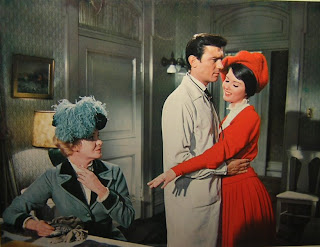
Spend an afternoon at the theater with the films of Rodgers and Hammerstein's "The King and I" (directed by Walter Lang) and Tennessee Williams' "Summer and Smoke" (helmed by Peter Glenville), shown back-to-back starting at 3:45 p.m.
12 December: An irresistible force meets an immovable object in Charles Walters' "The Tender Trap," starring Frank Sinatra and Debbie Reynolds (and David Wayne and Celeste Holm), airing at 1:30 p.m., followed by Roy Rowland's "Meet Me in Las Vegas," featuring two of the screen's greatest dancers - Dan Daily and Cyd Charisse.
13 December: Hey, it's Van Heflin Day! Get started with Delmer Dave's "3:10 to Yuma," with Glenn Ford; George Sherman's "Count Three and Pray," with Joanne Woodward and Philip Carey; Mervyn LeRoy's "Johnyy Eager," with Lana Turner and Robert Taylor; Lewis Milestone's "The Strange Love of Martha Ivers," with Barbara Stanwyck and Fielder Cook's "Patterns," with Ed Begley and Everett Slaone.
Pencil in Mitchell Leisen's "Remember the Night," a rather tricky holiday film starring Barbara Stanwyck and Fred MacMurray that also plays on December 24th and 25th. Peter Godfrey's "Christmas in Connecticut" also airs this month today and on Decembeer 19th and 24th.
 14 December:
14 December: Spend Sunday, sweet Sunday, with Cary Grant, Myrna Loy and Shirley Temple in Irving Reis' "The Bachelor and the Boby-Soxer" and with Debbie Reynolds in Gene Kelly and Stanely Donen's "Singin' in the Rain" and Norman Taurog's "Bundle of Joy." It all starts at 6 a.m., with 'Bundle of Joy" encoring on December 23rd.
15 December: Curious late-night double bill - Wolfgang Petersen's "Das Boot" (all 209 endless minutes of it) and Edwin L. Marin's "Ringside Maisie," with the unsinkable Ann Sothern. Later in the day: Jerry Lewis, self-directed as "The Nutty Professor"; Jack Lemmon in Richard Murphy's "The Wackiest Ship in the Army," a film that sounds like a comedy but really isn't, and Joseph L. Mankiewicz's stilborn version of "Guys and Dolls," a musical that's never really as much fun as you think it should be.
16 December: Elvis made only three good films, in my opinion - Philip Dunne's "Wild in the Country" (based on a Clifford Odets script, no less); Gordon Douglas' "Follow That Dream" and Phil Karlson's solidly effective "Kid Galahad," costarring Gig Young, Lola Albright and Joan Blackman. The latter is being screened today at 4:15 p.m. Watch it.
17 December: Early Cliff Robertson - Robert Aldrich's very fine "Austum Leaves" (in which Cliff hurls a typewriter at Joan Crawford) and David Swift's all-star, sleazy "The Interns." Love affairs, '60s-style, are examined in Robert Mulligan's "Love with the Proper Stranger," with Steve McQueen and Natalie Wood, and Billy Wilder's "The Apartment," with Jack Lemmon and Shirley MacLaine.
 18 December:
18 December: Mercouri and Perkins! Together - At last. Kind of. Being screened are Jules Dassin's "Phaedra," "Topkapi" and "10:30 P.m. Summer" and Anatole Litvak's "Goodbye Again." Great Eurotrash - all of them And all of them preceded by Dassin's "Naked City." Later: Jacques Demy's "Model Shop," with Anouk Aimee and Gary Lockwood, and Hal Ashby's "Shampoo."
 19 December:
19 December: Arthur Hiller directs Sandy Dennis and Jack Lemmon in an original Neil Simon script, "The Out-of-Towners," an underrated comedy (in its day) that has grown better with age.
21 December: June Allyson, Peter Lawford and Joan McCracken frolic in Charles Walters' "Good News." More Disney: Gary Nelson's "The Black Hole," the John Hough duo, "Escape to Witch Mountain" and "Return to Witch Mountain," Robert Stevenson's "Bedknobs and Broomstick," Norman Tokar's "Candleshoe" and Nelson's "Freaky Friday."
22 December: Truffaut's "The 400 Blows" leads the pack, and then there's Geroge Roy Hill's debut film, "Period of Adjustment, Ralph Smart's "Bush Christmas" with Chips Rafferty and Frank Tashlin's "Susan Slept Here," with Debbie Reynolds and Dick Powell.
 27 December:
27 December: Movies don't get any more sophisticated than Stanely Done's "Indiscreet," starring,
yes, Cary Grant and Ingrid Bergman.
28 December: Aceric fun with Clark Gable, Doris Day and Gig Young in George Seaton's "Teacher's Pet."
29 December: Can't sleep? Tune in Lois Weber's revelatory "The Blot," Jacques Tati's very French "Les Vacances de Monsieur Hulot" and Fred Coe's good, gray "A Thousand Clowns." Later in the night, Turner honors Ron Howard with a new Richard Schickle documentary, screenings of Howard's first directorial effort, "Grand Theft Auto" and his Oscar-winning "A Beautiful Mind," and Anatol Litvak's "The Journey," in which a tiny Howard acted opposite an actor he'd later direct in "Parenthood" and "The Paper" - Jason Robards.

 30 December:
30 December: A rare showing of Alexander Macendrick's "Don't Make Waves," a comedy starring his "Sweet Smell of Success" star, Tony Curtis. Later: Trashy, generic fun with Richard Fleischer's inventive ande brilliant "Soylent Green" and Russell Rouse's "The Oscar."
31 December: Turner screens the complete version of Michael Cimino's legendary - and hastily and glibly maligned - "Heaven's Gate."
And then you can end the year with MGM's self-congratulatory "That's Entertainment!" trilogy, plus "That's Dancing!," in which Metro generously invited other studios to stand in its carefully placed spotlight. Jack Haley directed "That's Entertainment!" and "That's Dancing!," Gene Kelly helmed "That's Entertainment! II" and Burt Friedgen and Michael J. Sheridan directed "That's Entertainment! III." If this marathon doesn't test your affection for movie musicals, nothing will.

(
Artwork: Marilyn Monroe and Jane Russell in a production number cut from "Gentlemen Prefer Blondes," and on the cover of Life magazine; star of the month Joseph Cotten; Kim Novak and Jack Lemmon in "The Notorious Landlady"; poster art for "The King and I"; Geraldine Page, Laurence Harvey and Pamela Tiffin in "Summer and Smoke"; Debbie Reynolds, Gene kelly and Donald O'Connor in "Singin' in the Rain"; Natalie Wood and Steve McQueen in Love with the Proper Stranger"; Shirley MacLaine and Jack Lemmon in "The Apartment"; Cary Grant and Ingrid Bergman in "Indiscreet"; Ron Howard, now and then, and more of Jane and MM)
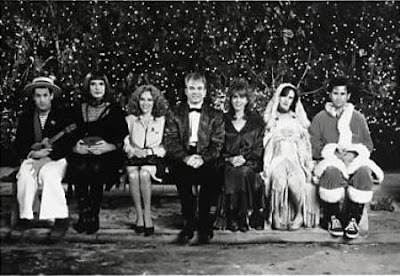 I know, I know. "Mixed Nuts" isn't exactly a lost film. I mean, it's available on DVD but, for 15 years, this nimble comedy has been willfully ignored.
I know, I know. "Mixed Nuts" isn't exactly a lost film. I mean, it's available on DVD but, for 15 years, this nimble comedy has been willfully ignored.